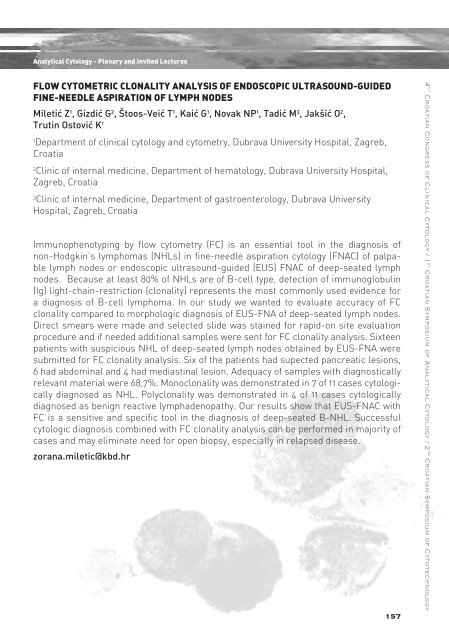4. Hrvatski kongres kliniËke citologije 4th Croatian Congress ... - Penta
4. Hrvatski kongres kliniËke citologije 4th Croatian Congress ... - Penta
4. Hrvatski kongres kliniËke citologije 4th Croatian Congress ... - Penta
You also want an ePaper? Increase the reach of your titles
YUMPU automatically turns print PDFs into web optimized ePapers that Google loves.
Analytical Cytology - Plenary and Invited Lectures<br />
FLOW CYTOMETRIC CLONALITY ANALYSIS OF ENDOSCOPIC ULTRASOUND-GUIDED<br />
FINE-NEEDLE ASPIRATION OF LYMPH NODES<br />
Miletić Z1 , Gizdić G2 , Štoos-Veić T1 , Kaić G1 , Novak NP1 , Tadić M3 , Jakšić O2 ,<br />
Trutin Ostović K1 1Department of clinical cytology and cytometry, Dubrava University Hospital, Zagreb,<br />
Croatia<br />
2Clinic of internal medicine, Department of hematology, Dubrava University Hospital,<br />
Zagreb, Croatia<br />
3Clinic of internal medicine, Department of gastroenterology, Dubrava University<br />
Hospital, Zagreb, Croatia<br />
Immunophenotyping by flow cytometry (FC) is an essential tool in the diagnosis of<br />
non-Hodgkin’s lymphomas (NHLs) in fine-needle aspiration cytology (FNAC) of palpable<br />
lymph nodes or endoscopic ultrasound-guided (EUS) FNAC of deep-seated lymph<br />
nodes. Because at least 80% of NHLs are of B-cell type, detection of immunoglobulin<br />
(Ig) light-chain-restriction (clonality) represents the most commonly used evidence for<br />
a diagnosis of B-cell lymphoma. In our study we wanted to evaluate accuracy of FC<br />
clonality compared to morphologic diagnosis of EUS-FNA of deep-seated lymph nodes.<br />
Direct smears were made and selected slide was stained for rapid-on site evaluation<br />
procedure and if needed additional samples were sent for FC clonality analysis. Sixteen<br />
patients with suspicious NHL of deep-seated lymph nodes obtained by EUS-FNA were<br />
submitted for FC clonality analysis. Six of the patients had supected pancreatic lesions,<br />
6 had abdominal and 4 had mediastinal lesion. Adequacy of samples with diagnostically<br />
relevant material were 68,7%. Monoclonality was demonstrated in 7 of 11 cases cytologically<br />
diagnosed as NHL. Polyclonality was demonstrated in 4 of 11 cases cytologically<br />
diagnosed as benign reactive lymphadenopathy. Our results show that EUS-FNAC with<br />
FC is a sensitive and specific tool in the diagnosis of deep-seated B-NHL. Successful<br />
cytologic diagnosis combined with FC clonality analysis can be performed in majority of<br />
cases and may eliminate need for open biopsy, especially in relapsed disease.<br />
zorana.miletic@kbd.hr<br />
157<br />
4 th <strong>Croatian</strong> <strong>Congress</strong> of Clinical Cytology / 1 st <strong>Croatian</strong> Symposium of Analytical Cytology / 2 nd <strong>Croatian</strong> Symposium of Cytotechnology


